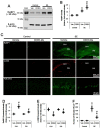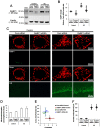CDDO-Me Attenuates CA1 Neuronal Death by Facilitating RalBP1-Mediated Mitochondrial Fission and 4-HNE Efflux in the Rat Hippocampus Following Status Epilepticus
- PMID: 35624848
- PMCID: PMC9137584
- DOI: 10.3390/antiox11050985
CDDO-Me Attenuates CA1 Neuronal Death by Facilitating RalBP1-Mediated Mitochondrial Fission and 4-HNE Efflux in the Rat Hippocampus Following Status Epilepticus
Abstract
Ras-related protein Ral-A (RalA)-binding protein 1 (RalBP1, also known as Ral-interacting protein of 76 kDa (RLIP76) or Ral-interacting protein 1 (RLIP1 or RIP1)) is involved in the efflux of 4-hydroxynonenal (4-HNE, an end product of lipid peroxidation), as well as mitochondrial fission. In the present study, we found that 2-cyano-3,12-dioxo-oleana-1,9(11)-dien-28-oic acid methyl ester (CDDO-Me) attenuated CA1 neuronal death and aberrant mitochondrial elongations in these neurons coupled with enhanced RalBP1 expression and reduced 4-HNE levels following status epilepticus (SE). RalBP1 knockdown did not affect mitochondrial dynamics and CA1 neuronal death under physiological and post-SE conditions. Following SE, however, cotreatment of RalBP1 siRNA diminished the effect of CDDO-Me on 4-HNE levels, mitochondrial hyperfusion in CA1 neurons, and CA1 neuronal death. These findings indicate that CDDO-Me may ameliorate CA1 neuronal death by facilitating RalBP1-mediated 4-HNE efflux and mitochondrial fission following SE. Therefore, our findings suggest that increased RalBP1 expression/activity may be one of the considerable targets to protect neurons from SE.
Keywords: FJB; mitochondrial dynamics; mitochondrial elongation; mitochondrial fragmentation; oxidative stress; seizure.
Conflict of interest statement
The authors declare no conflict of interest. The funders had no role in the design of the study; in the collection, analyses, or interpretation of data; in the writing of the manuscript, or in the decision to publish the results.
Figures







References
Grants and funding
LinkOut - more resources
Full Text Sources
Research Materials
Miscellaneous

